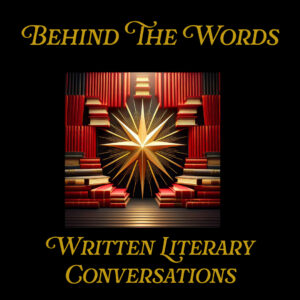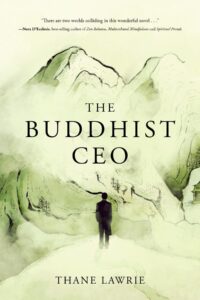
Written Literary Conversations with Nora D’Ecclesis
featuring Thane Lawrie
The Buddhist CEO

Nora D’Ecclesis: Why did you select the first person to write The Buddhist CEO?
Thane Lawrie: I hoped that writing in the first person would bring an intensity to the writing. My intention was that it would give the reader direct insight into the inner workings of Hamish’s mind as a CEO and a Buddhist. So much is written about CEO’s that makes them out to be heroes who always know exactly what to do and how to act. I thought by writing in first person I could really convey Hamish’s self-doubt and his inner anxieties, whilst still showing his ambition and skill at the same time. I also felt it was the best way to show the conflict he felt between his desire to be a dedicated Buddhist practitioner, whilst balancing his stressful life as a CEO. An internal first-person dialogue was the best way to showcase his dilemma, I felt.
Nora: Describe Hamish’s inner conflict associated with being the top management of a corporation and living the Buddhist precepts in meditative life.
Thane: Hamish had been trying to live a Buddhist life, based on the peaceful path of following the Buddhist precepts, a kind of moral code, for about twenty years by the time he became a CEO. Somewhat ironically, it was his living a perceptual life that had led to his being promoted throughout his career. He felt that the precepts encouraged him to be honest, hardworking, diligent, and to get on with people. This played out in the workplace, where this approach to life resulted in getting jobs done. His ability to get things done amicably was soon noticed by management and led to his promotions, culminating in becoming a CEO.
He struggled as to whether he should take the CEO role, as he suspected this might result in conflict between his work life and spiritual life. He succumbed to worldly pressures and realised that the salary increase was such that it would allow his family to live well. He also felt that the CEO role would allow him to do lots of good if he could genuinely lead as a Buddhist CEO.
For the first few years, he thrived in the role. He treated staff well, in accordance with Buddhist principles. He also stood up to bullies, and this gained him respect, and soon the company was transformed. However, over time, a few senior staff didn’t come with him on certain issues. They started to form their own opinions and views about how things should be done and secretly plotted against him. He found this hard to fathom, and he despaired when he had to get rid of some people and was even taken to court.
This caused deep conflict within Hamish. On one hand he wanted to live the meditative peaceful life. But when he meditated, he often just thought about the difficult situations he was facing at work. In the eyes of the world, he was a success, but in his eyes, that of a want-to-be peaceful Buddhist, he felt less happy and content, and this bothered him.
Nora: Please explain Segaki, a Buddhist concept concerning the process of death.
Thane: Segaki is the name of chapter 7 in The Buddhist CEO. It refers to the ancient Zen Buddhist ceremony called Segaki. The ceremony is for any being, human or non-human, who has not found peace in the next life. The ceremony involves decorating a Buddhist altar with all kinds of food, even food for animals as well. There is an elaborate service with the blowing of conch shells, the beat of drums and crashing of symbols. This is done to invite the dead to the altar so they can drink and eat the Dharma (Buddhist teachings), be blessed by the ceremony, and make peace with themselves in the afterlife.
The ceremony can also point to this life as well. How we strive to satisfy ourselves with experiences and acquiring things, but like the spirits, we often do not feel satisfied and are confused as to why. The ceremony pointing to the fact it is often by living simply and humbly when we feel spiritually nourished. It certainly made me think.
I have taken part in this ceremony myself, and it is deeply moving.
Nora: How did you select the names of your characters? Hamish and Morag vs Elaine and Arthur?
Thane: I found selecting the names of characters very difficult throughout the book. I have no idea if other authors find this difficult, but I did. Hamish was the only name that was easy for me. I have always loved the name Hamish. I am Scottish, and Hamish is a very traditional name in Scotland. If I could have chosen my own name, it would have been Hamish. One of my own sons has the middle name Hamish. I feel very Scottish, and I wanted my main character to be very Scottish too.
I played around with the other names in the book quite a bit. I wanted Hamish’s wife to be very Scottish too, and she was given the name Beth, another old traditional Scottish name. The other names were trickier, but I played around with different names until they felt right for the character.
I still get people I know who share a name with a character asking why I called a character after them. I didn’t ever call any of the characters after people I know, but names are powerful symbols, and people find it hard to believe that sometimes.
Nora: Of all the scenes in your novel, which is your favorite from CEO Journey vs Buddhist Journey?
Thane: My favourite scene is in chapter 7 and encompasses Hamish’s CEO and Buddhist journeys. He is tired and jaded and recognises that he needs a rest from his CEO life. He turns to his favourite place, a Buddhist monastery called Throssel Hole in northern England. When he arrives at the monastery, he has some free time before the retreat begins. He takes a walk up to the top of the monastery grounds and sits in the silence, taking in the beautiful mountain scene in front of him. Here he sits, comparing his busy life with the peace of the monastery and the incredible valley it is situated in. He recalls a story about his dog, which recently passed away and wonders if the love of his dog is part of the reason why he came to Segaki. I feel this is my favourite scene in the book.
Nora: Do you want each book to stand alone, or will your next novel be part two?
Thane: I am writing a second book, which will follow on from The Buddhist CEO and continue Hamish’s journey. I see the second book as being able to be read standalone, but also to be clearly a book 2 of the original story, but the second book will still be able to be enjoyed as a standalone too.
Nora: Is there such a thing as the idea of writer’s block? If so, how do you break through it or avoid it?
Thane: I have read about writer’s block, where a writer just can’t think at all about the next section of their book. Thankfully, I never experienced that as such. However, there were times when I could tell that what I was writing was not as good, and it just didn’t flow as easily as other times. When I felt his, I put the book down for a few days and tried not to think about it at all. This seemed to work, and after a few days, I was back in the flow and the words and ideas came more easily again. Writer’s block must be a terrible thing to experience.
Nora: Which of all the marketing methods has worked well for you?
Thane: A Marketing the book has been interesting as I am not a trained marketer as such. A few things have worked well for the book. My publisher Koehler Books ran a poll before the book was published asking people to choose between two designs for the front cover. Roughly 600 people voted on their favourite design, and it generated a lot of interest in the book. Interestingly the vote was fairly evenly split between the two designs!
Another marketing tool that worked well happened by chance. LA Radio picked up on my book and did a couple of interviews with me. The woman who interviewed me oversaw organising a party that was connected to the OSCARS in Hollywood. She took my book to this party and several stars were photographed holding the book, Ajay Mehta who starred in the Sopranos and Sex in the City, Issac Singleton the voice of the God Thanos in the Marvel movies were two of several stars photographed with the book. This generated a lot of interest on social media.
My X (formerly Twitter) account @BuddhistCEO generated some interest, and for a while, I posted a zen poem every day. I eventually ran out of steam and found I couldn’t keep it up, but I still post occasionally. My website ThaneLawrie.com, where I write a regular blog, also gained some traction.
Nora: As a writer, what would you select as your avatar and why?
Thane: My avatar would likely be a small person sitting in meditation with a large mountain behind him. I love Zen art, and such an avatar would remind me of that. The principle involved is the idea that the person meditating, is hopefully happy in themselves, but in the grand scheme of the mountains and cosmos all around them, their life is small and inconsequential. I like this idea, it reminds me to try live well and peacefully but also not to take myself too seriously.
To find out more about Thane Lawrie and the book The Buddhist CEO, visit the websites: